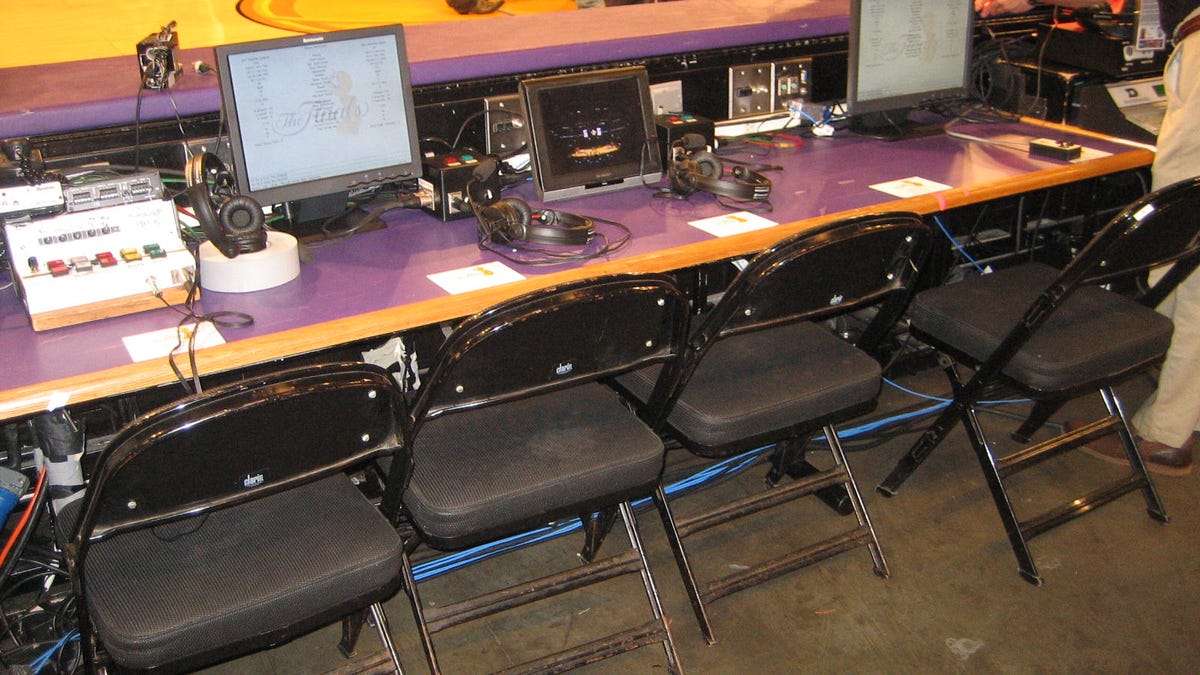Backstage tech tour at the NBA Finals
CNET News.com's Erica Ogg gets a behind-the-scenes look at the technology used in gathering, analyzing, and distributing real-time statistics in Game 3 of the NBA Finals.

LOS ANGELES--Never mind the nail-biting lead changes down the stretch, or the dazzling display put on by league MVP Kobe Bryant here at Game 3 of the NBA Finals.
Try also to forget Jack Nicholson holding court from his usual spot at Staples Center. Shrug off the fact that Sylvester Stallone, Eddie Murphy, David Beckham, and Hugh Hefner are all sitting a few feet away. One of the biggest stars in Los Angeles Tuesday night stayed quietly out of sight.
Logging the mind-boggling amount of statistics produced in a single National Basketball Association game is an intense undertaking. And the league has fine-tuned a tech setup to get the job done. A private network, a series of tablet PCs, and a precision PC-powered timing system have to work perfectly in concert to collect, process, and deliver game details posthaste.
And in the case of the finals, technology partner Lenovo has used both teams' statistics to predict the future. Here at Staples Center, before Game 3 between the Los Angeles Lakers and the Boston Celtics, I'm told that a technology called the Lenovo Stat has already predicted the winner of the series.
With a plus-minus statistic developed by the PC maker, the Stat determines the best possible five-player combination for each team, and it rates them according to their output and effect on their team. The Lenovo Stat, featured on NBA.com, is also distributed to coaches and players.
In the playoffs, the Boston Celtics have a leading rating of +79, the Lakers are right behind, at +66. We'll see what happens, but so far, the series is led by Boston, 2 games to 1, after the Lakers won Tuesday night (to this LA girl's supreme delight), 87 to 81.
But back to the technology. Before tip-off, I got a look at who and what is behind producing the incredibly detailed and specific real-time stats for a game.
"Stats are the language of our sport--or any sport, really," said Steve Hellmuth, NBA executive vice president of operations and technology. That is why the NBA logs statistics of its games in exhaustive detail. In real time, they are processed and fed to media outlets covering the game.
Ensuring that no potential stats go unlogged during the nearly 500 possessions of a single game requires a technical coordinator, a play spotter, and two people tasked with stat input.
Recorded plays include tipped passes, missed shots, illegal picks, charging fouls, and, of course, points scored, rebounds, and assists. In 1,300 regular-season NBA games, that amounts to more than 675,000 statistical events logged, according to Lenovo. At all 29 NBA arenas, the data input specialists use a no-frills ThinkPad X61 tablet PC.
The data is instantly sent to the scoreboards plastered all around the court, the with related graphics appearing on the televised broadcast of the game, NBA.com, as well as scores of monitors scattered about the arena at press tables and announcer booths.
The information is also sent over the NBA's private network to Secaucus, N.J., where a host of inputters log metadata related to game highlights. These contribute to the league's digital-video archive, searchable by players, coaches, TV analysts, and even referees looking for trends and details from the video footage, according to Hellmuth, who has had a hand in developing the high-tech statistics-gathering processes for both the NBA and Major League Baseball.
The NBA's also taken to perfecting the timing of the game with special computers. Down at the scorer's table, closer on the edge of the court, is a ThinkPad, which acts as a "parser." It records every time the game clock is stopped and started again.
It's synched up with a remote unit the referees wear on their belts. Every time one of them blows their whistle, the sound sends a signal to the belt unit, which tells the clock to stop and start. The system, used by most college sports arenas as well, was invented by Michael Costabile, president of Precision Time.
The league uses this method because it's the least error-prone. "A human takes two-tenths of a second" to stop the clock after hearing the referee's whistle, said Hellmuth. "That's why we say 'a game is 48 minutes long, more or less'--because there are humans on every side of it."

